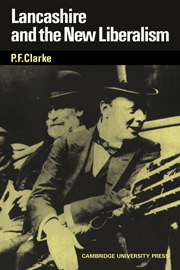Book contents
- Frontmatter
- Contents
- Preface
- Abbreviations
- Dedication
- PART ONE INTRODUCTION
- PART TWO FORMATIVE INFLUENCES
- PART THREE THE TERMS OF THE CONTEST
- PART FOUR THE RECONSTITUTION OF LIBERAL LANCASHIRE
- PART FIVE FIELDS OF RECRUITMENT
- PART SIX GOING TO THE COUNTRY
- PART SEVEN CONCLUSION
- 15 Edwardian Progressivism
- APPENDICES
- Bibliography
- Index
15 - Edwardian Progressivism
Published online by Cambridge University Press: 23 November 2009
- Frontmatter
- Contents
- Preface
- Abbreviations
- Dedication
- PART ONE INTRODUCTION
- PART TWO FORMATIVE INFLUENCES
- PART THREE THE TERMS OF THE CONTEST
- PART FOUR THE RECONSTITUTION OF LIBERAL LANCASHIRE
- PART FIVE FIELDS OF RECRUITMENT
- PART SIX GOING TO THE COUNTRY
- PART SEVEN CONCLUSION
- 15 Edwardian Progressivism
- APPENDICES
- Bibliography
- Index
Summary
A: Who's writing the Long to-night?
B: C.P.
A: What is the subject?
B: Saving Lloyd George's soul again.
Manchester Guardian office, c. 1925After 1906 the electoral prospects of the Liberal party depended upon keeping social and economic issues to the fore. The difficulties in which the Government was enmeshed just before the Great War, on the other hand, arose largely through the legacies of Home Rule and Welsh Disestablishment, from which there could be no escape. The settlement of these questions – however necessary, however overdue – held up for the time being the development of social policy. ‘More than ever before’, Lord Crewe had written in 1905, ‘the Liberal party is on its trial as an engine for securing social reforms, – taxation, land, housing, etc. It has to resist the I.L.P. claim to be the only friend of the workers. Can it do this and attempt Home Rule as well?’ By 1914 it was having to try. Some of the Tariff Reformers were prepared to fight progressivism on its own terms and boldly put forward their own economic policy.‘It is quite possible, however’, Bonar Law told a Manchester candidate in 1913, ‘that the question of Home Rule may become so acute that all other questions will sink; and indeed, I hope this will be the case.’
- Type
- Chapter
- Information
- Lancashire and the New Liberalism , pp. 393 - 408Publisher: Cambridge University PressPrint publication year: 1971



